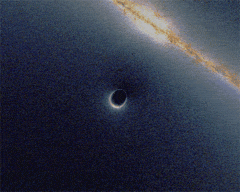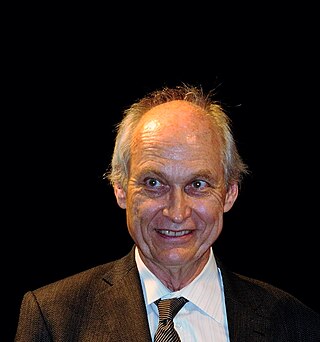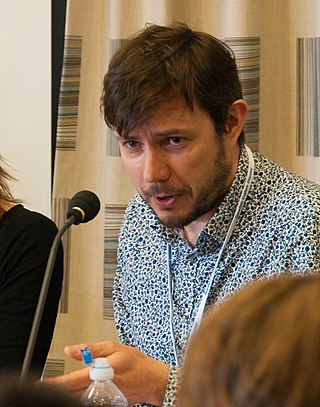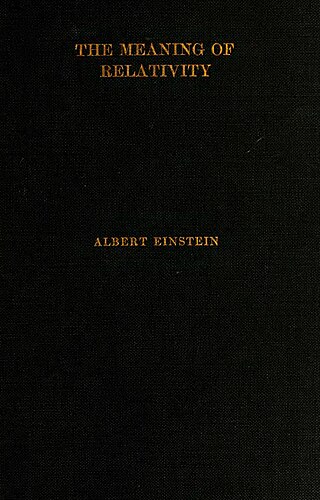
The Big Bang is a physical theory that describes how the universe expanded from an initial state of high density and temperature. The notion of an expanding universe was first scientifically originated by physicist Alexander Friedmann in 1922 with the mathematical derivation of the Friedmann equations. The earliest empirical observation of the notion of an expanding universe is known as Hubble's law, published in work by physicist Edwin Hubble in 1929, which discerned that galaxies are moving away from Earth at a rate that accelerates proportionally with distance. Independent of Friedmann's work, and independent of Hubble's observations, physicist Georges Lemaître proposed that the universe emerged from a "primeval atom" in 1931, introducing the modern notion of the Big Bang.

A gravitational singularity, spacetime singularity, or simply singularity, is a theoretical condition in which gravity is predicted to be so intense that spacetime itself would break down catastrophically. As such, a singularity is by definition no longer part of the regular spacetime and cannot be determined by "where" or "when". Gravitational singularities exist at a junction between general relativity and quantum mechanics; therefore, the properties of the singularity cannot be described without an established theory of quantum gravity. Trying to find a complete and precise definition of singularities in the theory of general relativity, the current best theory of gravity, remains a difficult problem. A singularity in general relativity can be defined by the scalar invariant curvature becoming infinite or, better, by a geodesic being incomplete.
Hawking radiation is emission released outside a black hole's event horizon according to a model developed by Stephen Hawking in 1974. The radiation was not predicted by previous models which assumed that once electromagnetic radiation is inside the event horizon, it cannot escape. Hawking radiation is predicted to be extremely faint and is many orders of magnitude below the current best telescopes' detecting ability.

Edward Mills Purcell was an American physicist who shared the 1952 Nobel Prize for Physics for his independent discovery of nuclear magnetic resonance in liquids and in solids. Nuclear magnetic resonance (NMR) has become widely used to study the molecular structure of pure materials and the composition of mixtures. Friends and colleagues knew him as Ed Purcell.

Michael S. Turner is an American theoretical cosmologist who coined the term dark energy in 1998. He is the Rauner Distinguished Service Professor Emeritus of Physics at the University of Chicago, having previously served as the Bruce V. & Diana M. Rauner Distinguished Service Professor, and as the assistant director for Mathematical and Physical Sciences for the US National Science Foundation.

Cosmology is a branch of physics and metaphysics dealing with the nature of the universe, the cosmos. The term cosmology was first used in English in 1656 in Thomas Blount's Glossographia, and in 1731 taken up in Latin by German philosopher Christian Wolff in Cosmologia Generalis. Religious or mythological cosmology is a body of beliefs based on mythological, religious, and esoteric literature and traditions of creation myths and eschatology. In the science of astronomy, cosmology is concerned with the study of the chronology of the universe.

Tom Mike Apostol was an American mathematician and professor at the California Institute of Technology specializing in analytic number theory, best known as the author of widely used mathematical textbooks.
Jay Myron Pasachoff was an American astronomer. Pasachoff was Field Memorial Professor of Astronomy at Williams College and the author of textbooks and tradebooks in astronomy, physics, mathematics, and other sciences.
The Mechanical Universe...And Beyond is a 52-part telecourse, filmed at the California Institute of Technology, that introduces university level physics, covering topics from Copernicus to quantum mechanics. The 1985-86 series was produced by Caltech and INTELECOM, a nonprofit consortium of California community colleges now known as Intelecom Learning, with financial support from Annenberg/CPB. The series, which aired on PBS affiliate stations before being distributed on LaserDisc and eventually YouTube, is known for its use of computer animation.

Wolfgang Rindler was an Austrian physicist working in the field of general relativity where he is known for introducing the term "event horizon", Rindler coordinates, and for the use of spinors in general relativity. An honorary member of the Austrian Academy of Sciences and foreign member of the Accademia delle Scienze di Torino, he was also a prolific textbook author.

Andrew Fraknoi is a retired professor of astronomy recognized for his lifetime of work using everyday language to make astronomy more accessible and popular for both students and the general public. In 2017 Fraknoi retired from his position as Chair of the Department of Astronomy at Foothill College. In retirement he continues to teach through the Fromm Institute for Lifelong Learning and the Osher Lifelong Learning Institute at San Francisco State University, to give public lectures, and to add to his body of written work. He is the recipient of numerous awards and honors in his field.
Edwin Floriman Taylor is an American physicist known for his contributions to the teaching of physics. Taylor was editor of the American Journal of Physics, and is author of several introductory books to physics. In 1998 he was awarded the Oersted Medal for his contributions to the teaching of physics.
The Lillian McDermott Medal, established in 2021, is awarded annually by the American Association of Physics Teachers (AAPT). Named after Lillian Christie McDermott, the Medal "recognizes those who are passionate and tenacious about improving the teaching and learning of physics and have made intellectually creative contributions in this area".

Jeffrey Robert Forshaw is a British particle physicist with a special interest in quantum chromodynamics (QCD): the study of the behaviour of subatomic particles, using data from the HERA particle accelerator, Tevatron particle accelerator and the Large Hadron Collider (LHC) at CERN. Since 2004 he has been professor of particle physics in the School of Physics and Astronomy at the University of Manchester.

Classical Electrodynamics is a textbook written by theoretical particle and nuclear physicist John David Jackson. The book originated as lecture notes that Jackson prepared for teaching graduate-level electromagnetism first at McGill University and then at the University of Illinois at Urbana-Champaign. Intended for graduate students, and often known as Jackson for short, it has been a standard reference on its subject since its first publication in 1962.
Eugene Hecht is an American physicist and author of a standard work in optics.

Electricity and Magnetism is a standard textbook in electromagnetism originally written by Nobel laureate Edward Mills Purcell in 1963. Along with David Griffiths' Introduction to Electrodynamics, this book is one of the most widely adopted undergraduate textbooks in electromagnetism. A Sputnik-era project funded by the National Science Foundation grant, the book is influential for its use of relativity in the presentation of the subject at the undergraduate level. In 1999, it was noted by Norman Foster Ramsey Jr. that the book was widely adopted and has many foreign translations.

The Meaning of Relativity: Four Lectures Delivered at Princeton University, May 1921 is a book published by Princeton University Press in 1922 that compiled the 1921 Stafford Little Lectures at Princeton University, given by Albert Einstein. The lectures were translated into English by Edwin Plimpton Adams. The lectures and the subsequent book were Einstein's last attempt to provide a comprehensive overview of his theory of relativity and is his only book that provides an accessible overview of the physics and mathematics of general relativity. Einstein explained his goal in the preface of the book's German edition by stating he "wanted to summarize the principal thoughts and mathematical methods of relativity theory" and that his "principal aim was to let the fundamentals in the entire train of thought of the theory emerge clearly". Among other reviews, the lectures were the subject of the 2017 book The Formative Years of Relativity: The History and Meaning of Einstein's Princeton Lectures by Hanoch Gutfreund and Jürgen Renn.

Lectures on Theoretical Physics is a six-volume series of physics textbooks translated from Arnold Sommerfeld's classic German texts Vorlesungen über Theoretische Physik. The series includes the volumes Mechanics, Mechanics of Deformable Bodies, Electrodynamics, Optics, Thermodynamics and Statistical Mechanics, and Partial Differential Equations in Physics. Focusing on one subject each semester, the lectures formed a three-year cycle of courses that Sommerfeld repeatedly taught at the University of Munich for over thirty years. Sommerfeld's lectures were famous and he was held to be one of the greatest physics lecturers of his time.
Six Ideas that Shaped Physics is a textbook in calculus based physics, written by Thomas A. Moore based on his introductory course in college physics at Pomona College. It covers special relativity, quantum mechanics, and thermodynamics. The impetus for the project to author the book came from the 1987-1996 Introductory University Physics Project (IUPP), which found that most college texts neglected to teach topics in 20th century physics.













